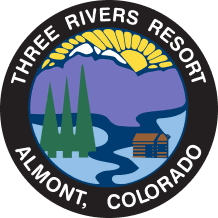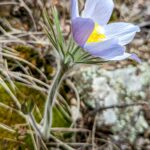
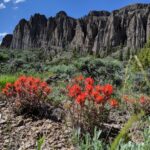
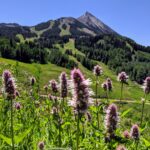
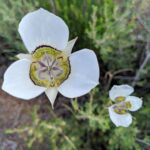
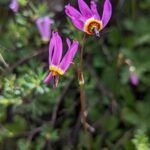
We have received some great press on our wildflowers recently, including an article in Travel and Leisure, plus a recent nod in People magazine. The Crested Butte Wildflower Festival is officially wrapping up now but the flowers will go on and on for a couple more months, so don’t fret if you missed the festival. If you’re a flower fanatic like I am, the fun part is seeing what each week brings, as it is ever changing.
Early Season
The first flowers we see in the spring (late April through May) are readily found in the southern end of Gunnison County, which is more of a high desert climate. The varieties of red paintbrush, cactus flowers, wallflowers and pasque flowers begin to emerge in late April and early May. The first place I go flower hunting is in Almont, on the hills above Three Rivers Resort. It is a thrill to see the first blooms emerging after a long, harsh winter.
When the north end of the valley starts to melt out, pasque flowers and glacier lilies abound in lower areas like Kebler Pass Road, the Lower Loop trails and Snodgrass Mountain. As runoff continues, a large variety of flowers will emerge in the wet, muddy places. These include red columbine, marsh marigolds, ball waterleaf, shooting stars, wild iris, prairie smoke, kings crown, and even the elusive fairy slippers (calypso orchids).
Peak Flower Time!
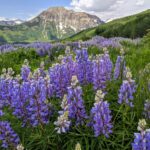 After this impressive opening act, the lupine begin their show, turning many of the surrounding hills purple. The Lupine and Deer Creek trails are most impressive for lupine viewing. Soon the many varieties of sunflowers take their turn, painting many other hillsides bright yellow. Look for the arrowleaf balsamroot first, especially around the southern end of the valley and in Almont. Then, the pervasive mule ears take over in Crested Butte, especially visible along Cement Creek Road and the Walrod Cutoff trail, or try a much easier stroll on the Brush Creek trail. Swampy Pass trail off of Ohio Creek Road is jaw dropping with fields of yellow against the contrasting silhouette of “the Castles.” Mixed into these ground level sunflowers are bright and tall Aspen sunflowers standing tall and usually solo.
After this impressive opening act, the lupine begin their show, turning many of the surrounding hills purple. The Lupine and Deer Creek trails are most impressive for lupine viewing. Soon the many varieties of sunflowers take their turn, painting many other hillsides bright yellow. Look for the arrowleaf balsamroot first, especially around the southern end of the valley and in Almont. Then, the pervasive mule ears take over in Crested Butte, especially visible along Cement Creek Road and the Walrod Cutoff trail, or try a much easier stroll on the Brush Creek trail. Swampy Pass trail off of Ohio Creek Road is jaw dropping with fields of yellow against the contrasting silhouette of “the Castles.” Mixed into these ground level sunflowers are bright and tall Aspen sunflowers standing tall and usually solo.
The peak of summer in mid to late July yields huge stands of wild roses, giant hyssop, the rainbow of columbine colors, thick areas of Case’s Fitweed, and fields of shoulder-high delphinium, corn lilies and green gentian with their hundreds of tiny flowers. Dotting the terrain everywhere are geranium, asters, Mariposa lilies, arnica, buckwheat and more. The sheer variety of wildflowers is dizzying.
Late Season
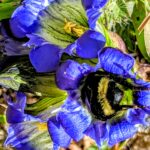 As summer marches on through August and into September Splendor, many flowers are still blooming well up in the higher areas. Try high mountain areas like Frigidaire Pass, Daisy Pass, Rustler’s Gulch, Blue Lake, Copper Lake. The fireweed shoots up and even looks great as it goes to seed. Cobalt-colored bottle gentian, wild raspberries, pearly everlasting and swaths of showy fleabane replace the fields of peak summer blooms. In the higher areas, rosy and sulphur paintbrush continue to bloom strong along with anemone, towering delphinium and buckwheat beginning to turn rosy.
As summer marches on through August and into September Splendor, many flowers are still blooming well up in the higher areas. Try high mountain areas like Frigidaire Pass, Daisy Pass, Rustler’s Gulch, Blue Lake, Copper Lake. The fireweed shoots up and even looks great as it goes to seed. Cobalt-colored bottle gentian, wild raspberries, pearly everlasting and swaths of showy fleabane replace the fields of peak summer blooms. In the higher areas, rosy and sulphur paintbrush continue to bloom strong along with anemone, towering delphinium and buckwheat beginning to turn rosy.
This highlights just a few of the local blooms but there is so much to experience in this “Wildflower Capital of Colorado.” We are fortunate to have such a constant feast for the eyes. Visit us June through September to witness the grandeur!

Jen Bickford is the General Manager at Three Rivers Resort and an amateur wildflower nerd. Stay in a cozy cabin, home, RV site or lodge room at the resort and you will be central to all the area has to offer from Gunnison, Crested Butte, Taylor Park, Blue Mesa Reservoir to Cottonwood Pass, Pitkin, Marble and every place in between!
